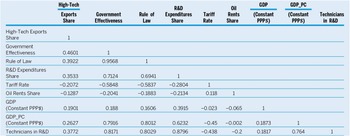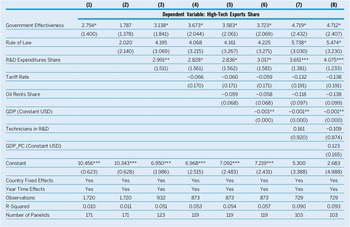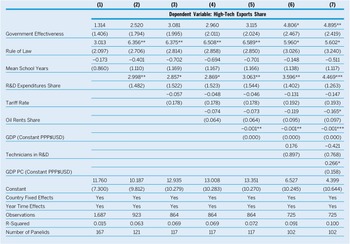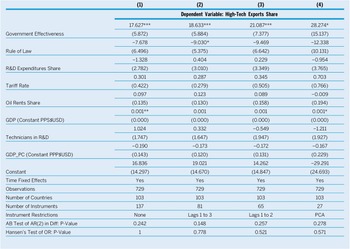The importance of technological innovation in promoting economic growth and competitiveness has captivated the attention of social scientists for a long time. In the mid-1950s, Solow (Reference Solow1956) further refined this point, which eventually earned him a Nobel Prize. Contrary to what was believed at the time, he demonstrated that long-term growth in advanced economies did not result from increases in inputs of labor and capital but rather from a “residual factor”—namely, technology—which thereafter came to be labeled as total factor productivity (TFP). Since Solow’s seminal work, there has been a growing consensus among economists that TFP is the main driver behind economic growth, but scholars differ about the nature of the phenomenon. For instance, early works posited that TFP is exogenous to the economic system (Solow Reference Solow1956). However, subsequent studies (Lucas Reference Lucas1988) contended that technological change is essentially an endogenous process because it is dependent on the ability of domestic human capital to generate learning through research and development (R&D). These differences notwithstanding, the relevance of these models is that they correctly predicted why the advanced industrial economies eventually “converged” to similar levels of gross domestic product (GDP) per capita after World War II by adopting similar technological productions. Likewise, these models imply that the continuous success of leading countries is contingent on their ability to constantly upgrade their technological innovation over time.
Since these early works, most of the economic studies have concentrated on the identification of those explanatory variables behind TFP. Broadly speaking, we can distinguish several and often interrelated streams of research. The first and largest group investigates the effect of macroeconomic variables, trade openness, and foreign direct investments (FDIs).Footnote 1 The second group emphasizes the importance of human capital because a highly trained labor force is deemed essential to improve productivity, as previously noted (Acemoglu Reference Acemoglu2010). The third is the institutional group, which postulates that socioeconomic institutions create the necessary incentives for innovation and growth.
Because technological innovation comprises a wide variety of products, this study focuses our analysis on high-tech exports. This is because high-tech exports are likely one of the most tangible aspects of technological innovation. The World Bank defines high-tech exports as “products with high R&D intensity, such as in aerospace, computers, pharmaceuticals, scientific instruments, and electrical machinery.”Footnote 2 There is a substantial amount of research demonstrating that high-tech exports have a pivotal role in GDP growth (Ekananda and Parlinggoman Reference Ekananda and Parlinggoman2017).
However, there is less consensus among scholars and market analysts on what are the main non-economic determinants of high-tech exports. In a recent review of the literature on this topic, He and Tian (Reference He and Tian2020) identified a host of other factors, including social and corporate culture, human capital, legal frameworks, business regulations, and taxation policies—all of which may encourage or deter innovation investments. Within this large body of literature, “institutions,” broadly defined, and their role in shaping innovation have received greater scholarly attention in recent years (Aghion, Antonin, and Bunel Reference Aghion, Antonin and Bunel2021). Institutional arguments often have been used in comparative analyses to explain divergent innovation paths in East Asia (Kim and Nelson Reference Kim and Nelson2000), Europe (Barbosa and Faria Reference Barbosa and Faria2011), and Latin America (Lemarchand Reference Lemarchand2015).
Some scholars have suggested that “good governance” is at the heart of institutional quality, which in turn causes technology exports to thrive (Fagerberg and Srholec Reference Fagerberg and Srholec2017). For the World Bank, “governance captures perceptions of the quality of public services, the quality of the civil service and the degree of its independence from political pressures, the quality of policy formulation and implementation, and the credibility of the government’s commitment to such policies.”Footnote 3 Accordingly, our study hypothesizes that the quality of governance institutions has a direct effect on the development of high-tech exports.
Some scholars have suggested that “good governance” is at the heart of institutional quality…
Our contribution to the existing literature is twofold. First, knowing the determinants of high-tech exports reveals which government policies should receive priority in the context of a country’s growth and development path. Within the set of possible determinants, political variables remain scarcely explored in many economic analyses that focus on high-tech exports (Tebaldi and Elmslie Reference Tebaldi and Elmslie2013). We therefore give particular attention to measures of governance institutions—that is, government effectiveness (GE), the rule of law (ROL), and corruption control—as potential drivers of high-tech exports.
…knowing the determinants of high-tech exports reveals which government policies should receive priority in the context of a country’s growth and development path.
From a methodological perspective, the second contribution of our analysis is from the choice of panel-data estimation techniques. Instead of relying on pooled or random-effects models, we use exclusively two-way fixed effects (TWFE) models that account for both unobserved time-invariant country-specific effects and unobserved country-invariant time effects. In addition, even after controlling for country- and time-specific unobserved variation as well as additional covariates, we were concerned about the potential endogeneity of the governance institutions variables. We thus used a system generalized method of moments (system GMM) approach to mitigate the potential attenuation bias of the institution estimates.
The main results of the differing estimation approaches highlight the importance of the quality of public institutions for high-tech exports, whereas other determinants such as the R&D expenditures share, the level of development (i.e., GDP per capita), and country size (i.e., GDP) also may be important but have coefficient estimates that appear to be less robust.
The main results of the differing estimation approaches highlight the importance of the quality of public institutions for high-tech exports…
APPROACHES TO THE STUDY OF HIGH-TECH EXPORTS
The empirical literature analyzing the drivers of high-tech exports tends to focus on only a few variables: human capital, FDIs, R&D expenditures, trade openness, and patents produced (Panda and Sharma Reference Panda and Sharma2020). This section summarizes some of the most important studies in this regard. In a cross-national sample of 54 countries, Seyoum (Reference Seyoum2004) showed that factor conditions (e.g., human resources and technology) are a strong predictor of exports performance. Using a panel of 19 Organisation for Economic Co-operation and Development (OECD) countries from1981 to 1999, Braunerhjelm and Thulin (Reference Braunerhjelm and Thulin2008) found evidence that an increase in R&D expenditures by one percentage point leads to a three-percentage-point increase in high-tech exports, whereas market size fails to attain significance. They also found that tax and regulatory systems influence the comparative dynamics of high-tech exports development.
Tebaldi (Reference Tebaldi2011) examined the determinants of high-tech exports from 1980 to 2008 using a panel data analysis. His study showed that democracy (measured by the Polity IV dataset; see www.systemicpeace.org/inscr/p4manualv2018.pdf) has only an indirect effect (via proximate factors) on high-tech exports, primarily through its effect on human capital, inflows of FDIs, and openness to international trade. For their part, Gökmen and Turen (Reference Gökmen and Turen2013), using a panel data analysis of 15 European Union (EU) countries between 1995 and 2010, concluded that the most important factors affecting high-tech exports are the levels of FDIs, human development, and economic freedom. All of them have an important role as drivers of high-tech exports. Another econometric study of the EU members demonstrated a strong relationship between R&D expenditures and the volume of high-tech exports (Sandu and Ciocănel Reference Sandu and Ciocănel2014). Sara, Jackson, and Upchurch’s (Reference Sara, Jackson and Upchurch2012) panel data analysis of high-tech exports as a percentage of the total manufactured exports of 120 countries between 2005 and 2015 suggested that the innovative capability of a country is a significant determinant of the share of high-tech products.
Furthermore, other studies highlight the importance of different factors in addition to those mentioned previously. For instance, Sepehrdoust, Tartar, and Davarikish (Reference Sepehrdoust, Tartar and Davarikish2021) focused on scientific productivity and different measures of risks as determinants of high-tech exports. They adopted a vector-autoregressive regression method to analyze emerging markets between 1996 and 2015. Their results indicate that economic risk, scientific productivity, financial risk, and political risk have the most effects on high-tech exports. Drapkin, Gainetdinova, and Panzabekova (Reference Drapkin, Gainetdinova and Panzabekova2021) instead applied their panel data model to Central and Eastern European countries from 1995 to 2018. Contrary to previous studies, they did not find either FDIs or R&D to be relevant. Rather, the most important determinants of high-tech exports are wages and resource prices, trade openness, tax-rate regimes, the unemployment rate, and the quality of human capital. Adding to the debate is Mulliqi (Reference Mulliqi2021), for whom high-tech exports—based on his analysis of 27 European countries—are highly dependent on the number of people receiving tertiary education. Finally, Navarro Zapata, Arrazola, and de Hevia (Reference Navarro Zapata, Maria and de Hevia2023) examined 35 OECD countries during the 2004–2018 period. Their results suggest that physical and human capital, FDIs, high-tech manufacturing imports, R&D-driven innovation, imports of high-tech manufactures, the size of the exporting economy, and EU membership all have a significant and positive role in determining high-tech exports.
GOVERNMENT INSTITUTIONS AND TECHNOLOGICAL DEVELOPMENT
This cursory review of the academic literature highlights the importance of a wide array of macroeconomic factors in fostering high-tech exports. However, economies do not function in a political vacuum—quite the contrary. As Taylor (Reference Taylor2016) pointed out, governmental decisions heavily influence high-tech-exports innovation in two important ways. The first is through funding and research coordination. Historically, governmental initiatives have been a catalyst of technological innovation. The role of government has been particularly important in funding basic research, which may be ignored by private investors due to their high costs and their need to provide quick financial returns to their investors (Aghion, Antonin, and Bunel Reference Aghion, Antonin and Bunel2021). In the United States, Isaacson (Reference Isaacson2019) noted that “the creation of a triangular relationship between government, industry, and academia was, in its own way, one of the significant innovations that helped produce the technological revolution of the late 20th century.”Footnote 4 Indeed, basic research has been the cornerstone of most innovation benefiting private companies, has had high social returns, and—more generally—has been an engine of economic growth. It is not surprising that North American, Western European, and—more recently—East Asian governments (Rodrik Reference Rodrik2006) consistently have outperformed the rest of the world in terms of R&D expenditures as a percentage of their GDP to remain internationally competitive in terms of high-tech exports, as theorized by Solow (Reference Solow1956).
The second way refers to the quality of government institutions (broadly defined), which provide the building foundations that facilitate (or hinder) scientific research in an extensive but tangible sense. According to Wolf (Reference Wolf2021), “successful development demands the creation of a range of vital public goods, [and] depends on a development-oriented government. But the latter in turn relies on the ability of private business to seize opportunities. A good way to think about this is as a marriage of cooperation with competition within an open world economy.”
Although many economic analyses that examine the impact of R&D on high-tech exports take institutions for granted, successful examples of high-tech innovation point not only to government’s active involvement in funding research but also to a high degree of government institutional effectiveness in providing a wide array of public goods. These public goods are the foundations of an environment within which innovation can flourish and contribute to long-term growth (Alesina et al. Reference Alesina, Aghion, Trebbi, Helpman and Helpman2008).
Regarding the importance of government institutions, Taylor (Reference Taylor2016, 20) contended that “the political environment can have a major impact on high-tech business strategies, networks, and performance.” To flourish, high-tech exports must operate within political systems whose institutions are highly effective in ensuring political stability, upholding the ROL, protecting property rights, limiting corruption, promoting policies and regulations that foster private entrepreneurship, maintaining high-quality public services, and ensuring that policies are carried out steadily over the long term by a professional bureaucracy. These are all “intangibles” that, in the real world of international business, make a difference. In the mid-1990s, the World Bank (2005) recognized that these factors are key components of the “good-governance” concept (see the online appendix) and are instrumental for economic reforms to succeed (Kaufmann, Kraay, and Zoido-Lobaton Reference Kaufmann, Kraay and Zoido-Lobaton2000). Indeed, subsequent studies have shown that institution building is a prerequisite for fostering high-quality innovation (Rodríguez-Pose Reference Rodríguez-Pose2013).
A few scholars adopted the institutional approach to explain technological innovation. Indeed, the effect of the quality of government institutions on technological innovation has been demonstrated only recently by a few empirical studies. At the cross-national level, Tebaldi and Emslie (Reference Tebaldi and Elmslie2013) found that institutional quality—measured through corruption control, property-rights protection, market-friendly policies, and an effective judiciary—significantly improves an economy’s rate of innovation. Similarly, Kawataba and Camargo (Reference Kawabata and Camargo2020) used the World Bank’s government indicators to determine their impact on innovation in a sample of 127 countries. Their regression results indicated that, after controlling for FDIs and investments in R&D, the effectiveness of public administration and regulatory quality are associated with innovation activities. Shifting the focus to the regional level, Rodríguez-Pose and Di Cataldo (Reference Rodríguez-Pose and Di Cataldo2015) showed that the effectiveness of regional governments has a direct effect on local innovative performance. More specifically, they argued that effective government is fundamental to “design long-term innovation strategies, target the right areas of investment and to implement the adequate measures that would make these strategies effective” (Rodríguez-Pose and Di Cataldo Reference Rodríguez-Pose and Di Cataldo2015, 6). Conversely, weak institutional settings create major obstacles for innovation policies. Similar conclusions came from Africa. A panel data analysis using GE indicators as explanatory variables concluded that in 40 countries, regulatory quality and GE positively affected innovation rates (Oluwatobi et al. Reference Oluwatobi, Efobi, Olurinola and Alege2015).
HYPOTHESIS
The previous discussion highlights the fact that effective government institutions are instrumental in the process of formulating, funding, and carrying out research over the long term. The resulting policies lead to the coordination of the interaction among stakeholders (e.g., government departments, research laboratories, and private investors); new scientific discoveries; the diffusion of scientific knowledge; and the protection of patents’ property rights against intellectual piracy—all of which are factors that reduce the uncertainty of new projects and, accordingly, stimulate R&D activities. Moreover, a professional bureaucracy that can expedite trade and regulatory hurdles, corruption control, and stable political institutions that can assure policy predictability and sustainability are all factors that matter in enhancing GE relative to high-tech exports.
However, whereas most of the literature is interested in the nexus between technological innovation and macroeconomic factors, none of the studies examine whether governance can shape high-tech exports per se, which is one of the most tangible aspects of technological innovation. Our aim was to fill this important gap in the literature. Consequently, we hypothesized that the quality of governance institutions directly conditions high-tech exports.
EMPIRICAL METHODOLOGY
Our baseline empirical estimations are based on the TWFE panel model. There are many advantages of using a panel approach compared to cross-sectional and time-series models. By far, the most important advantage is the ability to control for both unobserved time-invariant country-specific heterogeneity and unobserved country-invariant time heterogeneity. The specific TWFE used in our analysis is given as follows:
where HTEit measures the high-tech exports share; G it denotes measures of governance such as the effectiveness of government institutions and the ROLFootnote 5; and X it denotes a vector of time-varying control variables such as the R&D expenditures share or the (economic) size of a country.Footnote 6
The TWFE model estimates country effects (μi) to capture time-invariant country-specific heterogeneity as well as time effects (νt) to account for unobserved time-variant factors that are common to all countries (e.g., worldwide recessions and booms). The idiosyncratic disturbance term εit is assumed to be uncorrelated with all observations of the elements of both G and X . Furthermore, the draws from the joint distribution of G , X , and ε are assumed to be independent and identically distributed across countries (i=1,…,n). Due to the likely possibility that the time-varying variables and thus εit also exhibit autocorrelation, we used clustered standard errors that belong to the group of heteroskedasticity and autocorrelation-consistent standard errors.
To identify the causal effect of governance on the high-tech exports share, there must be assurance that the governance variables are indeed exogenous—that is, that the elements of G are uncorrelated with the disturbance term εit. With the exogeneity assumption of G doubtful and in the absence of plausible and valid external instruments for governance, we re-estimated equation (1) using the system GMM estimator,Footnote 7 which has been shown to efficiently address the potential endogeneity bias of the right-hand-side regressors.Footnote 8
The system GMM estimator requires that the residuals of the first difference equation are free of second-order autocorrelation. Therefore, we report the p-value of the AR(2) test developed by Arellano and Bond (Reference Arellano and Bond1991). A p-value greater than 0.05 indicates that the null hypothesis of “no second-degree autocorrelation of the residuals” cannot be rejected.
Furthermore, we used the two-step method to calculate the covariance matrix that has been shown to be robust. However, due to its downward bias of the standard errors in finite samples, we used the finite-sample correction of Windmeijer (Reference Windmeijer2005).
One of the pitfalls of GMM estimators is instrument proliferation—that is, when the number of instruments exceeds the number of cross-sectional units of the panel dataset. Although many instruments increase the efficiency of the GMM estimator, they also introduce inconsistency of estimates due to overfitting, which can be severe (Newey and Smith Reference Newey and Smith2004). In addition to bias, instrument proliferation lowers the power of specification tests, such as Hansen’s test (Hansen Reference Hansen1982) for overidentification restrictions.
We addressed the issue of instrument proliferation in two ways. First, we restricted the number of lags used as instruments (only two and three lags, respectively). Second, we used principal component analysis (PCA) to replace the GMM-type instruments with their principal components. Compared to instrument truncation, the PCA approach is somewhat less arbitrary. We reported p-values of Hansen’s test for overidentification restrictions for the full model. A p-value greater than 0.05 indicates that we cannot reject the null hypothesis, implying that the instrumental variables are determined to be valid.Footnote 9
DATA
The data used for this study, covering the period between 2007 and 2019, are from various sources (Manzetti and Osang Reference Manzetti and Osang2024). Both measures of governance—the GE and the ROL indexes—are from the World Bank’s Worldwide Governance Indicators (WGI) dataset (see https://info.worldbank.org/governance/wgi). The WGI variables are composite indexes that combine and weigh mass and expert surveys from a wide variety of sources (e.g., polling organizations and multilateral agencies), the numbers of which vary depending on the country. The strength of the WGI depends on several factors. They are the largest and most widely used datasets of their type, accounting for most of the countries in the world. These aggregate data also allow comparability across countries. Thus, they enable the creation of quantitative measurements for statistical analyses that can facilitate the move from country studies to broad cross-national comparisons. This, in turn, helps to assess differences across countries on the same governance indicator. It is worth noting, however, that Kurtz and Shrank (Reference Kurtz and Schrank2007), among others, have criticized the WGI due to conceptual, selection-bias, and aggregation problems.Footnote 10 However, an extensive WGI test by Charron (Reference Charron2010) and the underlying data show robust internal consistency around their concepts, and the rankings generally are quite stable.
All other variables—the dependent variable (high-tech exports) and the time-varying control variables—are from the World Bank’s WDI data bank (see https://databank.worldbank.org/source/world-development-indicators). Average years of schooling used in the regressions shown in table 3 are from Barro and Lee (Reference Barro and Lee2013). A list with a detailed description of all variables used in this study is presented in table 1a.
Table 1a Variable Definitions and Data Sources

Summary statistics (i.e., grand mean, its standard deviation, and maximum and minimum values) are shown in table 1b. Within and between summary statistics are available on request. Table 1c contains the (grand) correlation coefficient for each variable pair.
Table 1b Summary Statistics
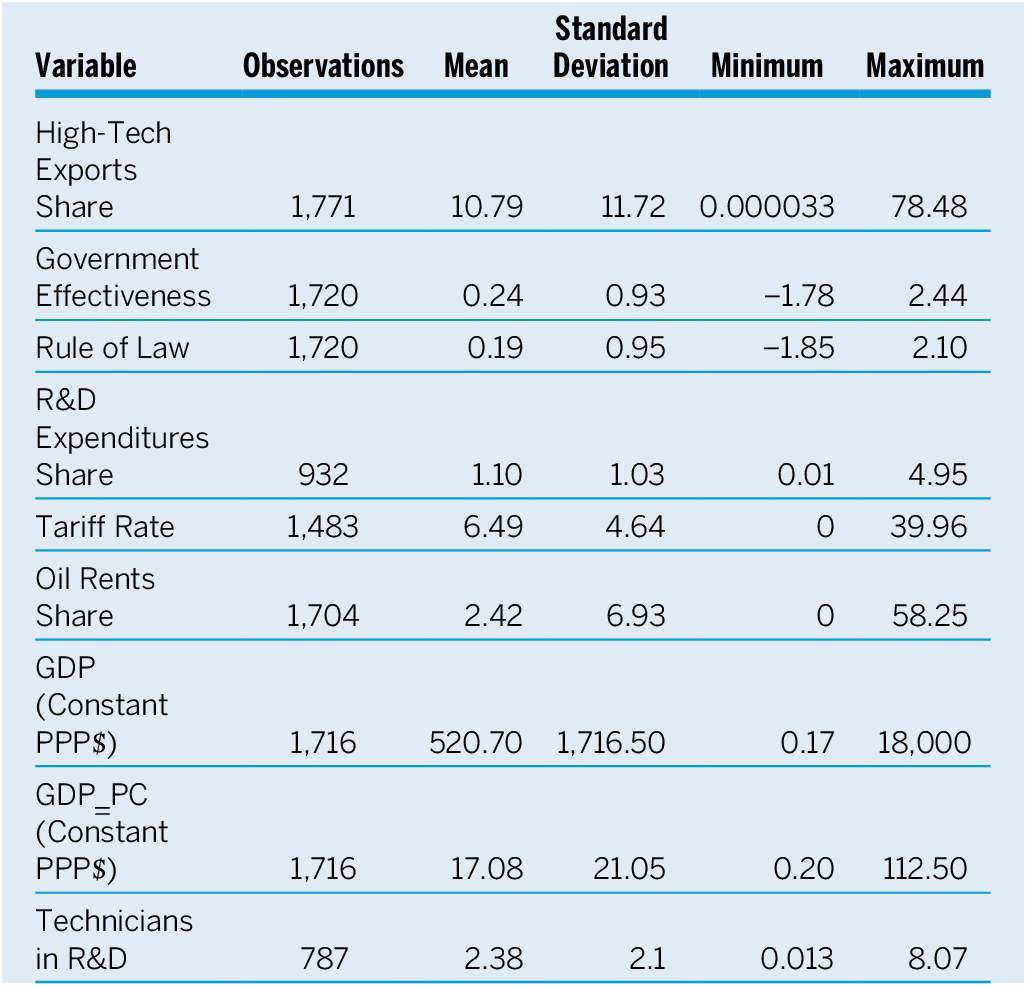
Table 1c Correlation Coefficients
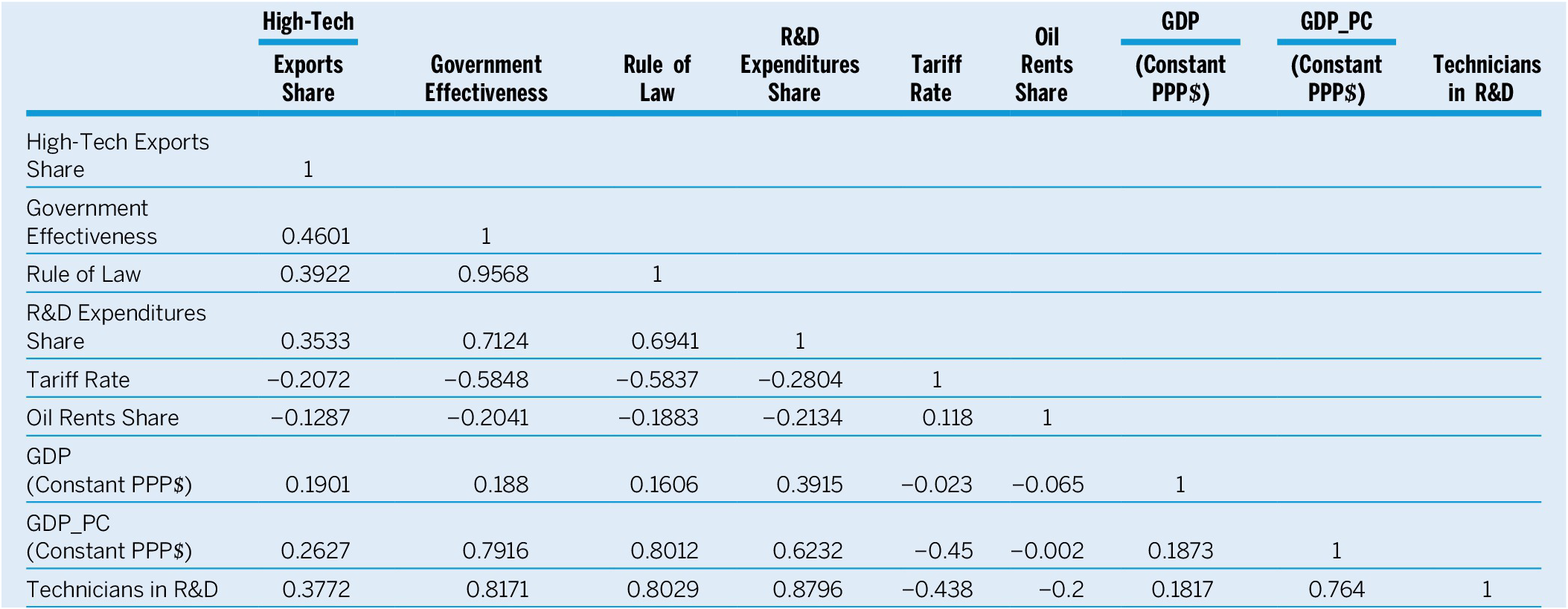
As a visual demonstration of the variability of high-tech exports both across countries and over time, we plotted the high-tech exports share for 10 countriesFootnote 11 for the 2007–2019 period (figure 1). As shown in figure 1, the high-tech exports share varies substantially both across countries (from 0 to almost 30%) and over time.

Figure 1 High-Tech Exports Share, 2007–2019
EMPIRICAL RESULTS
The main results from our baseline TWFE panel estimations are shown in table 2. The estimate in column 1 shows a positive, statistically significant relationship between GE and the high-tech exports share. A unit increase in GE is associated with an increase in the export shares by 2.75, or 275 basis points. This positive and significant relationship between GE and high-tech exports remains intact as more variables are added to the regression, although the point estimates vary from 1.8 to 4.8. The coefficient estimates of our second measure of governance, the ROL, are positive as well but statistically insignificant except for two specifications (see table 2, column 7 and 8).
Table 2 Baseline Results: Two-Way Fixed Effects Panel Regressions

Notes: Robust standard errors are in parentheses. ***p<0.01, **p<0.05, *p<0.1.
Standard errors are clustered at the country level.
Whereas most of the parameter estimates for the control variables have the expected signs, they vary in their significance level. Only the R&D expenditures share and a country’s economic size (i.e., GDP) have a statistically significant correlation with high-tech exports. Higher spending on R&D increases high-tech exports, as expected, whereas large economies tend to underperform in terms of high-tech exports compared to smaller nations. Restricting trade has the expected negative impact on high-tech exports but the relationship is not significant. Finally, the level of economic development (i.e., GDP per capita) and the number of technicians engaged in R&D have positive but insignificant point estimates.
Because the level of education of a country’s work force may have an important role in producing and exporting high-tech goods, we re-estimated models 2 through 8 in table 2 by including the average years of education of a country’s adult population as an additional control. The results are shown in table 3. Accounting for a country’s level of education does not qualitatively change the main results of table 2. Good governance is still a positive and significant factor with respect to high-tech exports, but now ROL is the mostly significant indicator whereas GE is only significant in two model specifications (columns 6 and 7). In the most comprehensive model specification (see table 3, column 7), the negative impact of being an oil-exporter nation is statistically significant, as is the positive effect of GDP per capita.
Table 3 Two-Way Fixed Effects Panel Regressions with Educational Achievement
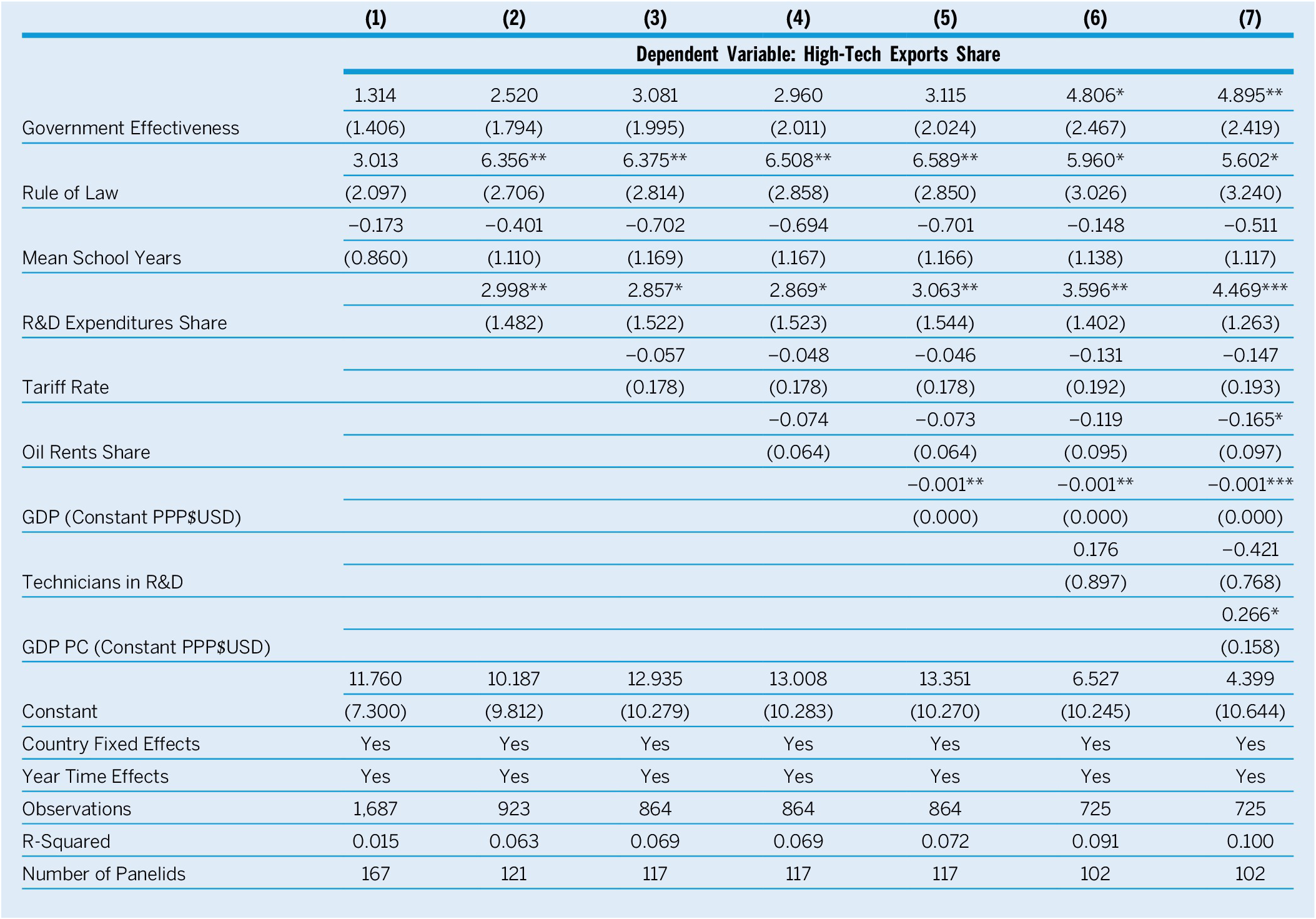
Notes: Robust standard errors are in parentheses: ***p<0.01, **p<0.05, *p<0.1.
Standard errors are clustered at the country level.
Most important, although the partial correlation coefficient between years of education and the high-tech exports share is positive (see table 1b), the impact of education is insignificant in the multivariate context. Due to the high positive partial correlation between education and the two governance measures, R&D expenditures share, technicians in R&D, and GDP per capita, the education covariate generates little additional explanatory power beyond that of the other measures.
Replacing the Barro–Lee (Reference Barro and Lee2013) education measure with various alternative measures of educational attainment—that is, primary, secondary, and tertiary school enrollment rates; number of secondary students enrolled in technical and vocational education programs; share of youth not in education, employment, or training; and progression to secondary school as a percentage of the number of students enrolled in the final grade of primary school—produces similar (i.e., insignificant) results.
To address the issue of potential endogeneity bias of our main variables of interest (i.e., GE and ROL), we re-estimated the comprehensive model (see table 3, column 7) using the system GMM estimator. The results are shown in table 4. To address the issue of instrument proliferation, we estimated four versions of the model. In column 1, the number of instruments is unrestricted; in columns 2 and 3, we allow for only three and two lags, respectively, of the GMM-style instruments; and column 4 presents the results when the GMM instruments are replaced by their principal components.
Table 4 Two-Step System GMM Estimations

Notes: Robust finite sample bias-corrected standard errors (Windmeijer Reference Windmeijer2005): ***p<0.01, **<0.05, *p<0.1.
Standard errors are in parentheses.
PCA: Replaces GMM-style instruments with their principal components.
As expected, the results in column 1 show signs of instrument proliferation because the number of instruments (137) far exceeds the number of countries (103). This also is confirmed by the high p-value of Hansen’s test (1.0), with values close to 1.0 indicating instrument-proliferation bias (Roodman Reference Roodman2009b). Although the number of instruments in column 2 (83) is smaller than the cross-sectional dimension of the sample, it nevertheless is high, as is the p-value of Hansen’s test (0.778). Due to the stronger restrictions placed on the number of instruments in columns 3 and 4, instrument proliferation is much less likely to be an issue, thereby representing the most consistent estimates. In all four model specifications, the coefficient estimates for GE are positive and highly significant. The higher estimated parameter values (i.e., ranging from 17.6 to 28.3) compared to those in table 2 indicate a substantial attenuation bias of the GE estimates in the baseline regressions. Whereas most of the coefficient estimates of the remaining right-hand-side variables are insignificant, the positive and significant coefficient for GDP in column 4 indicates economies of scale as a favorable condition for high-tech exports.
CONCLUSION
The quality of government institutions, measured by GE and ROL, and their ability to provide effective means on which private corporations can develop highly competitive high-tech exports comprise an understudied missing link in the current literature. To the best of our knowledge, there have been no recent empirical studies providing strong evidence about the relationship between governance institutions and high-tech exports using a panel data approach covering many countries and time periods. This article fills this gap in the literature by showing that governance variables (GE and ROL) have a strong causal role in shaping high-tech exports. The policy implications of these findings are that the quality of government institutions, through private–public partnerships, or efficient bureaucratic management can create a virtuous cycle that fosters high-tech exports.
ACKNOWLEDGMENT
We thank the editors and three reviewers for their thoughtful comments and suggestions. We also gratefully acknowledge the helpful comments of participants at the Governance and Development Seminar of the Inter-American Development Bank.
DATA AVAILABILITY STATEMENT
Research documentation and data that support the findings of this study are openly available on the PS: Political Science & Politics Harvard Dataverse at https://doi.org/10.7910/DVN/CLL7OO. No proprietary data were used for this study.
CONFLICTS OF INTEREST
The authors declare that there are no ethical issues or conflicts of interest in this research.




